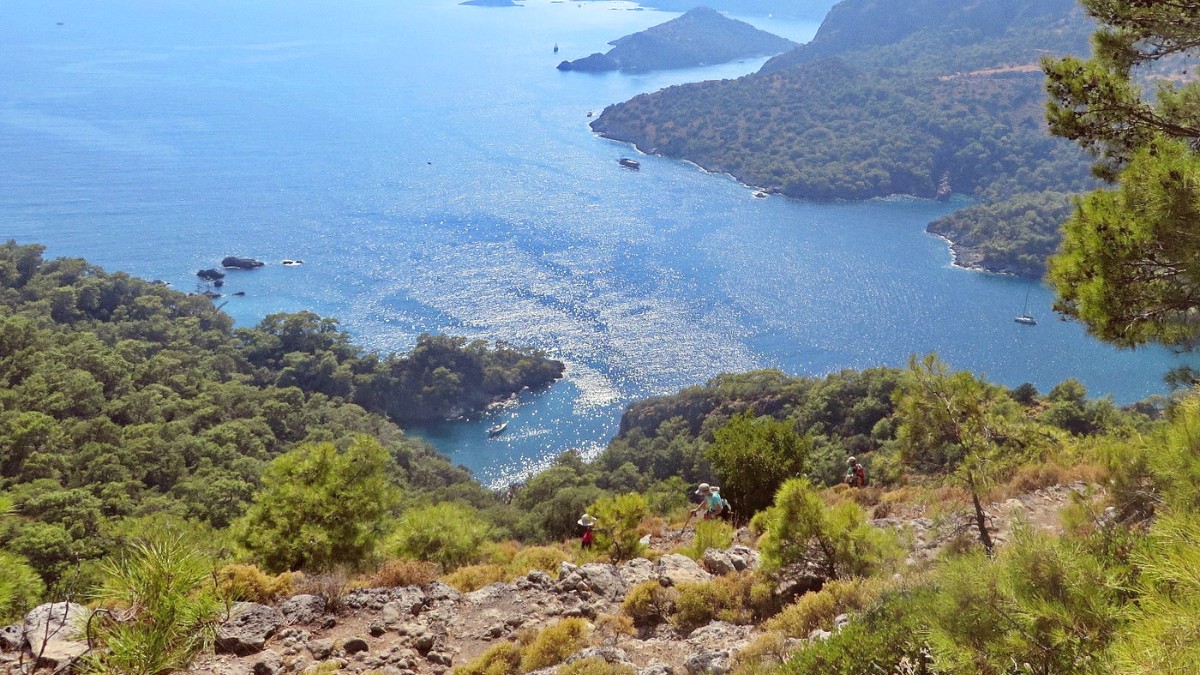
Mediterranean Coast, Turkey
This magnificent Lycian rock-cut tomb is carved directly into the sheer cliff face overlooking Fethiye, dating back to approximately 350 BC. Its elaborate facade, resembling a Greek temple, indicates the high status of the person buried within, likely Amyntas. Its prominent position served as a powerful declaration of presence and legacy, symbolizing advanced craftsmanship.
The Tomb of Amyntas is visible from most parts of Fethiye town. You reach the tomb via a steep but relatively short walk up from the town center. The path involves steps but rewards with close-up views of the carving. There is a small entry fee.
Easily accessible on foot from the Fethiye harbor.
The castle provides good views of Fethiye town, the harbor, and the surrounding bay, especially beautiful at sunset.
Exercise caution when exploring due to uneven terrain and lack of formal pathways. It is a rugged historical site.
While not grand, its ruins offer a quiet moment to reflect on Fethiye's past defensive history.
Visit in late afternoon to experience the sunset from this historical vantage point.
It's a less manicured site, offering a more authentic exploration experience.
Fethiye offers opportunities to explore the region's rich past through its museum.
Artifacts unearthed from Lycian sites: Telmessos, Tlos, Xanthos, Pinara.
Exhibits span the Lycian, Roman, and Byzantine periods.
Includes the Tragoedia Sarcophagus, pottery, jewelry, coins, and sculptures.
Open daily except Mondays.
There is an entry fee.
Located conveniently in the town center.
An abandoned Greek village, left desolate after the 1923 population exchange. Over 3,000 stone houses, two churches, and a school remain, standing empty as a poignant memorial. Wear sturdy shoes for uneven terrain. Bring a wide-angle camera lens for expansive ruins.
One of the oldest and most important Lycian cities, inhabited for over 4,000 years. Tlos features Lycian rock tombs, a Roman theatre, baths, and an acropolis. Offers impressive panoramic views of the Xanthos Valley. Often combined with Saklıkent Gorge tours.
Xanthos was the capital of the Lycian Federation, known for monumental tombs and distinctive architecture. Letoon, nearby, was the religious center of Lycia. These sites represent the height of Lycian civilization and are UNESCO World Heritage Sites. Allow sufficient time to explore both.
Another significant Lycian city, known for its numerous rock-cut tombs, including an unique "honeycomb" facade of smaller tombs. It also features a theatre, agora, and other ruins nestled into a beautiful, somewhat secluded valley. Pinara was thought to be a daughter city of Xanthos.
Fethiye’s natural beauty captivates, with stunning landscapes and pristine coastal areas.
A stunning turquoise lagoon with a white pebble beach, recognized as one of the most beautiful beaches worldwide. Protected as a national park, its calm, clear waters are perfect for swimming. There is an entry fee to the main protected area. Arrive early for tranquility. Pack a waterproof dry bag.
A secluded, dramatic valley mainly accessible by boat from Ölüdeniz. Known for high cliffs, waterfalls, and diverse butterfly species, especially the Jersey Tiger moth. It's a serene natural reserve. Wear sturdy shoes for the path to the waterfalls. Butterfly numbers vary by season.
One of Turkey's longest and deepest canyons. Visitors wade through icy, shallow waters, navigating narrow passages. The sheer rock walls create an imposing environment. An entry fee applies. Water shoes are highly recommended or can be rented. Consider water shoes.
A long pebble beach famous for reliable winds, popular for watersports like windsurfing and kitesurfing. Also known for spectacular sunsets over the Mediterranean Sea.
General birdwatching around wetlands near Çalış Beach. Sea turtles (Caretta caretta) are occasionally spotted during boat trips, especially near Iztuzu Beach (Turtle Beach) in Dalyan (a popular day trip).
Fethiye has pleasant municipal parks along its promenade, offering green spaces for relaxation and views of the harbor.
Numerous smaller, less-crowded bays and coves like Gemile Bay, Katrancı Bay, and Kıdrak Beach. Accessible by boat or car, offering secluded swimming spots.
Beyond the main tourist circuit, Fethiye offers lesser-known spots that provide tranquility.
Discover quiet corners away from the crowds for reflection and views.
Beyond the obvious shots of the Blue Lagoon and Tomb of Amyntas:
Capture sunset views from Çalış Beach, panoramic vistas from the Ölüdeniz cable car ascending Babadağ Mountain, the eerie beauty of Kayaköy Ghost Village in early morning mist, or the dramatic rock formations inside Saklıkent Gorge.
Discover areas beyond the main tourist circuit for unique experiences and tranquility.
While the entire 500+ km trail is famous, hiking smaller, less-trafficked sections close to Fethiye offers incredible views and solitude without committing to a multi-day trek.
Explore the smaller, local restaurants and cafes in Fethiye town center, away from the main tourist strip and harbor, for an authentic taste of daily life.
The villages along the Lycian Way, like Faralya (near Butterfly Valley) and Kabak Bay, are gaining popularity for their tranquil atmospheres.
Maximize your sightseeing adventure with these practical suggestions.
Comfortable walking shoes are a must for exploring historical sites and natural landscapes.
Integrate attractions into your itinerary for a balanced visit.
Early morning visits often provide fewer crowds and cooler temperatures.
For convenience, consider booking tickets for popular attractions or tours online in advance. GetYourGuide is a good platform.
Tickets are also available directly at the entrance of most sites. Look for official kiosks or visitor centers.
For visitors planning to see multiple historical sites, explore if a regional museum pass is available for cost savings. Inquire at Fethiye Museum.